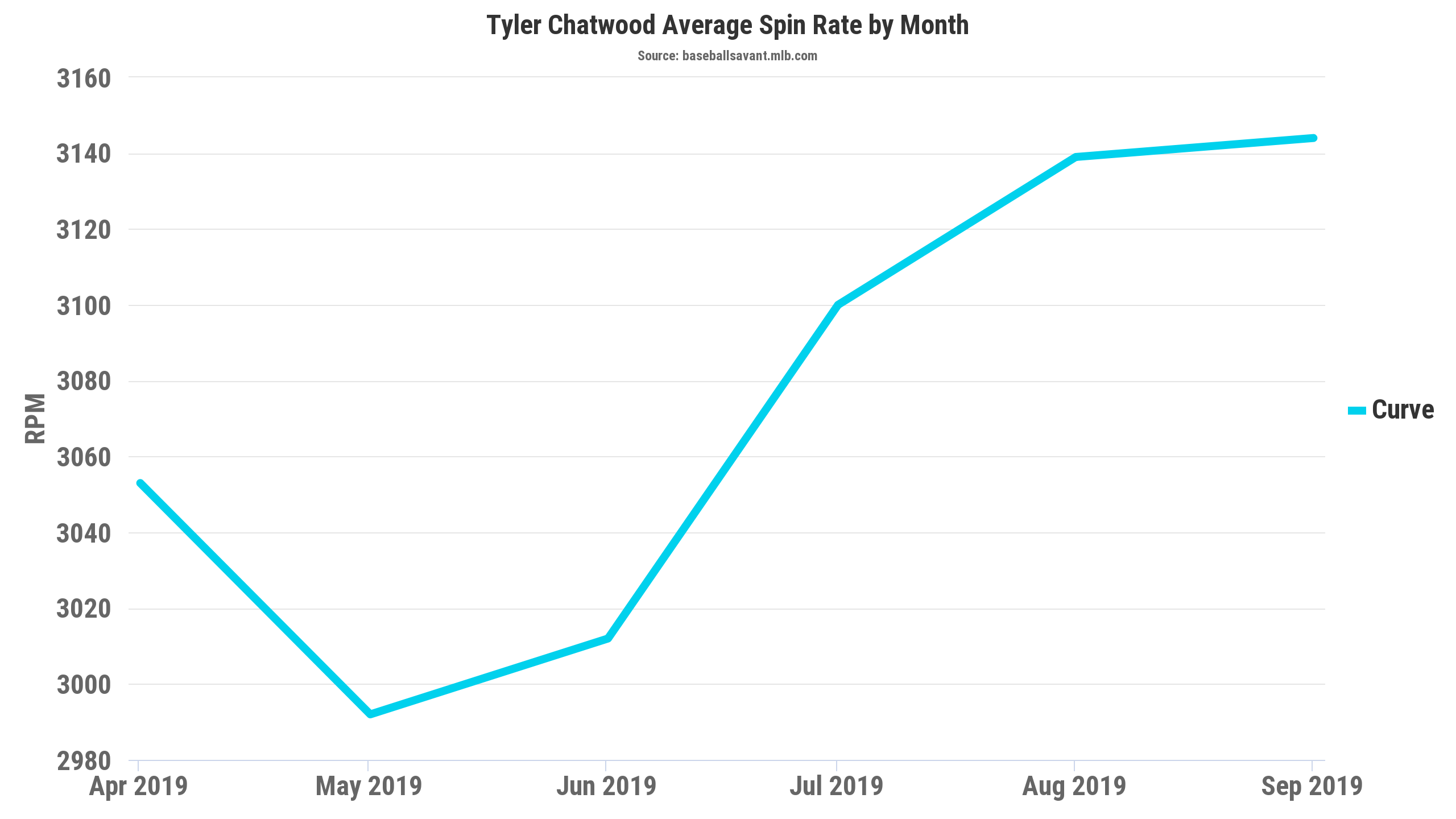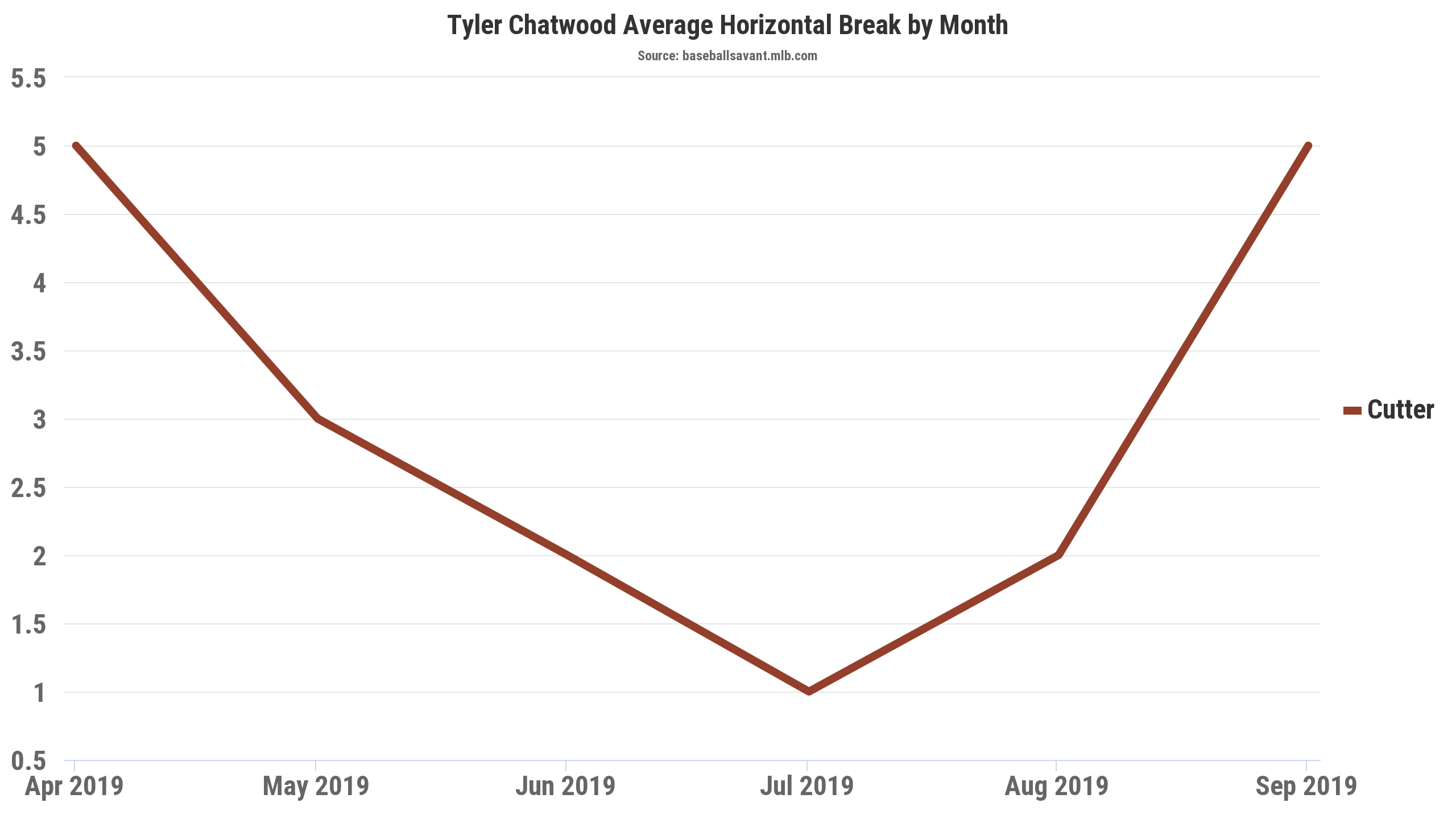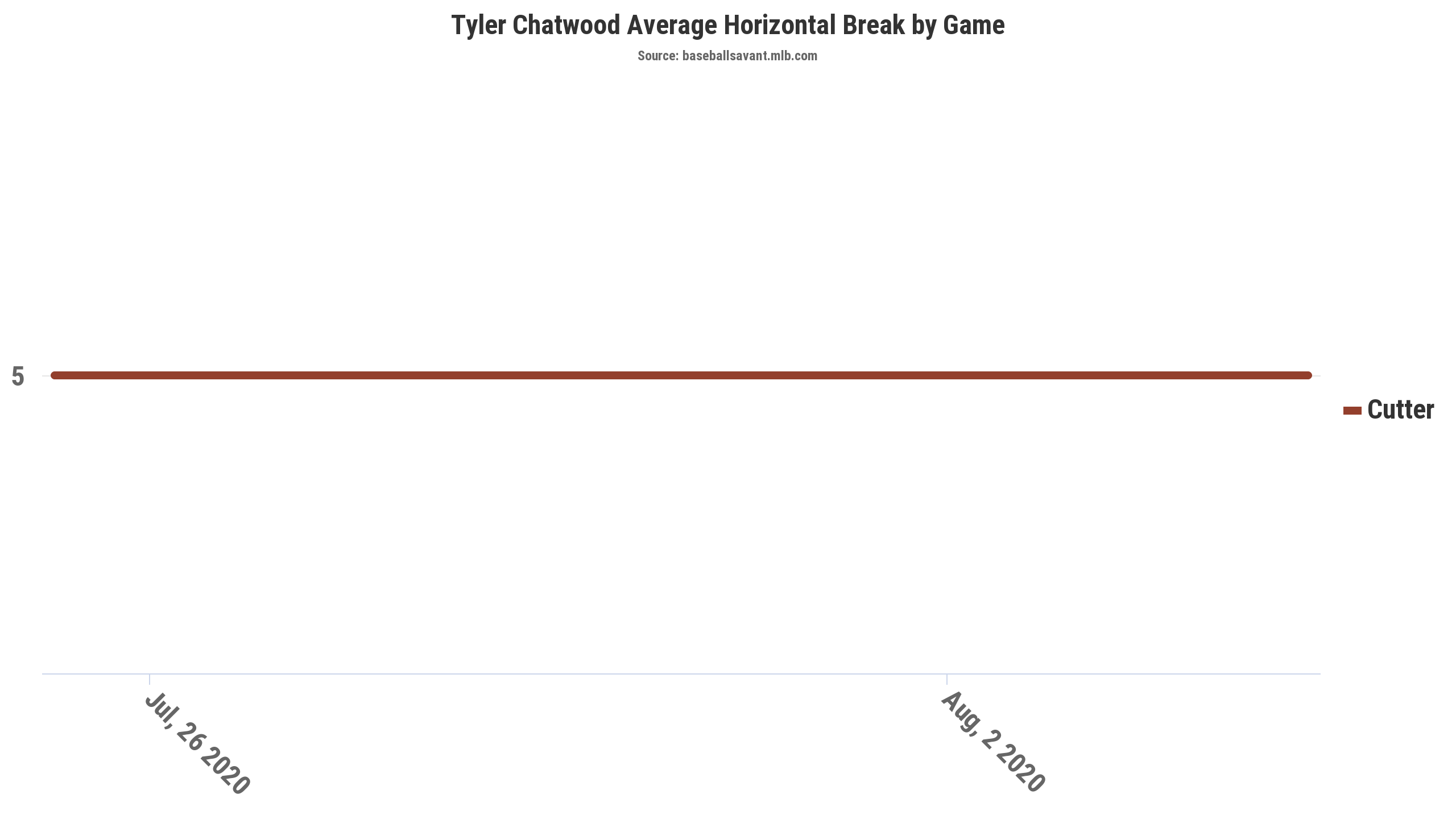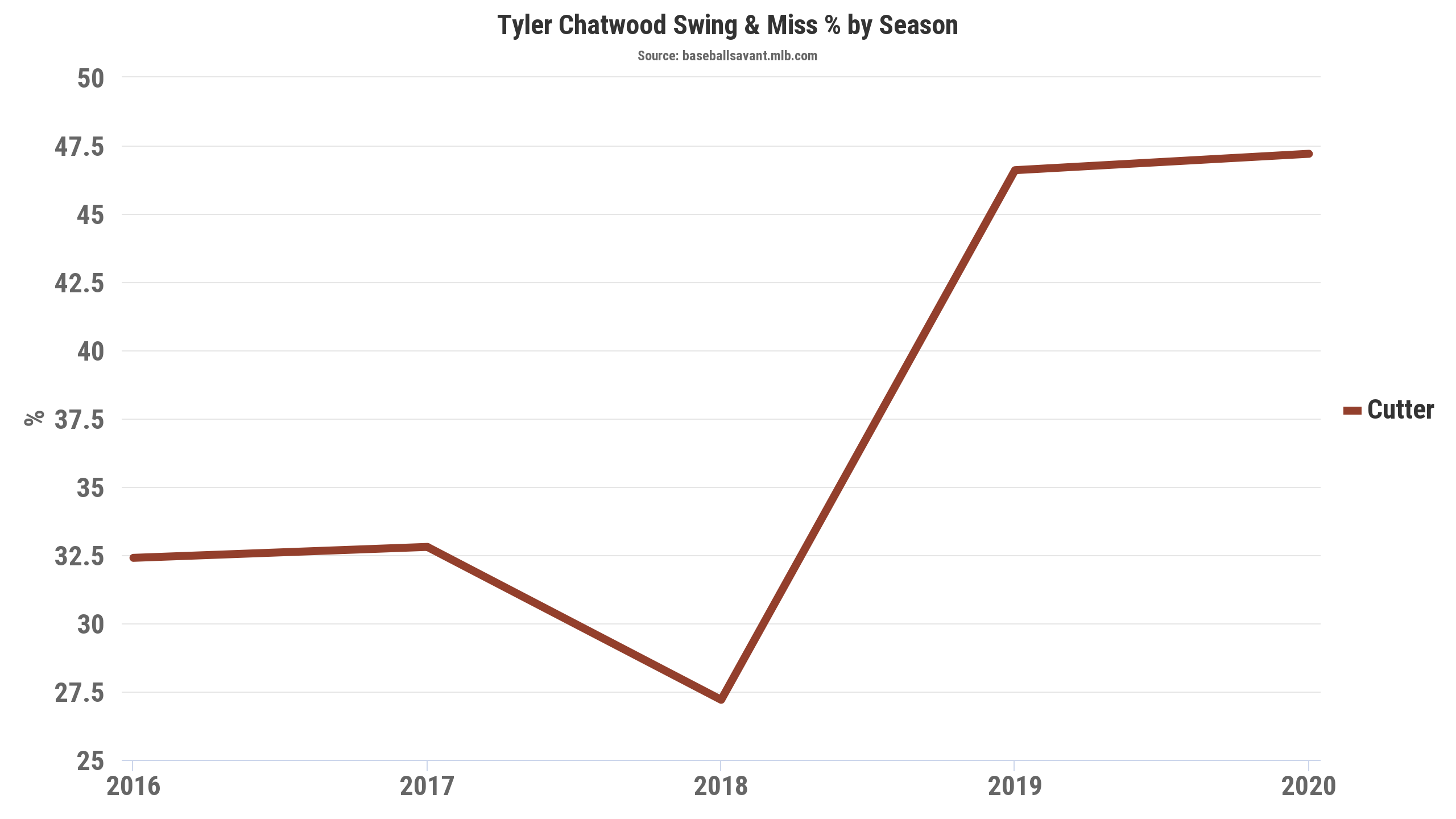The 2020 season was going to be anything but normal, we all knew that coming in. However, things have also been pretty strange when it just comes down to the game itself. Throughout the first few weeks of the season, there have been many unlikely stories, whether it’s that JaCoby Jones and Donovan Solano currently among the leaders in wRC+, or the Marlins being in first place despite having to shuffle out nearly half of their roster, there hasn’t been any shortage of fun and unusual stories so far in this shortened season.
The emergence of Tyler Chatwood as a quality starting pitcher this season is also one of those unlikely stories and not one that many would have predicted coming into the season. After all, Chatwood has only found himself in the Cubs starting rotation this season because of necessity, with the Cubs not adding much in the offseason and a Jose Quintana injury opening up another spot. Chatwood, of course, was somewhat of a big signing for the Cubs in the 2017 offseason, with the hope that Cubs could make him better at least in part by finally freeing him from Colorado. It hasn’t quite worked out to this point, but right now, Chatwood looks like a completely different pitcher from the one we were accustomed to seeing in the past couple of seasons.
He’s made three starts so far in 2020, two of which were great, in which he struck out 19 total batters across 12.2 innings and allowing just one run. While the other start was an absolute stinker, in which he allowed eight runs in less than three innings, there was still something encouraging to take away from it. He wasn’t walking batters, which was one of his biggest struggles in years prior. Even with that horrid third start against the Royals bringing his ERA on the season all the way up to 5.40, Chatwood still looks good on the whole this season, and it should be believed that he will be more like the pitcher we saw in the first two starts of the season as opposed to the one we saw against the Royals. After all, the peripheral stats still paint him in a quite favorable way, with a 2.46 FIP and a 2.56 SIERA, both among the best in the league.
Chatwood has made some serious improvements over the past year that appear to be driving this newfound success. The biggest thing about him as a pitcher throughout his career has been his control issues. Going back and looking at pitchers with at least 300 innings pitched from 2017 to 2019, Chatwood’s 14.5% walk rate is the worst by over two percentage points. That is the biggest factor in what drove his 2019 demotion to the bullpen, but also not to be forgotten is that Chatwood has had extremely drastic platoon splits, struggling heavily against left-handed hitters. Doing the same exercise that uncovered Chatwood having the highest walk rate from 2017 to 2019, we can see just how poor Chatwood has been against lefties.
| wOBA against, LHH | SLG against, LHH | |
|---|---|---|
| Tyler Chatwood | 0.375 | 0.464 |
| Rank (out of 123) | 120 | 102 |
It’s definitely hard to be a quality major league starting pitcher with such drastic platoon splits, and combined with those earlier command issues, the odds were stacked heavily against Chatwood’s success as a starting pitcher. But the tweaks he’s made through his pitch mix have helped tame his control and problems against opposite-handed hitters. made improvements to his stuff, as well as altering his pitch mix en route to the new and improved version we are seeing in 2020.
Better Stuff
Let’s first start with Chatwood’s better stuff. The improvements here started developing in 2019, and have been refined for 2020. The first notable improvement here has been in Chatwood’s curveball. His curveball has historically been his bread-and-butter pitch throughout his career, and a big part of what made him an attractive target as a free agent in the first place. Most notable, Chatwood’s curveball is of the high spin variety. Looking back from 2017 to 2019, Chatwood’s curveball generated an average of 2,968 RPM of spin, which placed him ninth among all pitchers who threw at least 100 of them in that span. This is a rate that helps aid big drop, which Chatwood usually gets plenty of. In 2019, it got even better, with Chatwood averaging over 3000 RPM of spin on the pitch for the first time in his career, giving him the third-best spin rate on the pitch of any pitcher in baseball. It led to him having more drop than ever on the offering.
Perhaps more encouragingly, Chatwood appeared to develop more spin on the pitch as the 2019 season progressed:

During the second half of 2019, Chatwood was getting a good amount more of spin than he had at any other point in the season, and after the all-star break he was generating an average RPM of 3,136 on his curveball, which was the fifth-best in baseball. It is perhaps not just a coincidence then that he also had some of his best performances of the season during that stretch. The highlights were a seven strikeout performance across three and two-thirds innings on Septemeber 1st, and a six strikeout performance in three innings on August 8th. Those heavy strikeout performances don’t look all that unlike Chatwood’s first two performances of the season, in which he had two of his best games in terms of strikeouts of his career.
This season, while Chatwood’s average curve spin isn’t above 3000 RPM so far, it is still quite good, sitting just under 3000 RPM at 2973 which again places him near the top of the leaderboards, where he currently sits eighth. It certainly looks like the improvements that Chatwood made in 2019 to further improve his curveball have indeed carried over to 2020.
As if tweaking your best weapon to make it better wasn’t enough, Chatwood also has a new weapon of choice this season, and this one is a lot more interesting. It’s a new-and-improved cutter. Like the improvements to his curveball, Chatwood’s improvements to his cutter started out in 2019. In years past, the pitch was never really anything special, and Chatwood used it at the lowest rate of his career in 2019:
| Season | Cutter % |
|---|---|
| 2016 | 20.2 |
| 2017 | 21.2 |
| 2018 | 25.7 |
| 2019 | 10.2 |
Later in the season, however, Chatwood began to turn to the pitch more, peaking at 16.8% usage in August. He also began to experiment with the pitch a little more. After all, he was essentially relegated to low-leverage situations, so it couldn’t hurt to try some new things out. He began to tinker with his grip and started to see improvements. The first main improvement appeared to be in terms of velocity. Chatwood threw the pitch harder in 2019 than in any other season in his career, notching almost two extra ticks in velocity up from 88.8 miles-per-hour in 2018 to 90.2 in 2019. The most notable improvement, though, was the pitch’s increased horizontal movement:

What you see in this graph is about five additional inches of horizontal break on the pitch in the month of September. This is notable because Chatwood has pretty much maintained that level of break through his first three starts in 2020. Get ready for the most boring graph you’ll ever see, which shows that Chatwood has indeed maintained that level of break:

Yup, there it is in all of its glory. Ironically, the flat line shows the pitch’s continued life. And his exact rate of 4.7 inches of horizontal break is among the best of all cutters in 2020:
| Player | Horizontal Movement |
|---|---|
| Kenley Jansen | 7.4 |
| Zach Davies | 7.1 |
| Aaron Civale | 5.7 |
| Zac Gallen | 5.5 |
| Jacob Barnes | 5.4 |
| Tyler Chatwood | 4.7 |
Which is part of the reason why the pitch is getting more whiffs than it ever has:

But enough with the numbers for now, and let’s just appreciate how nasty the pitch has been visually:
It is definitely a tough pitch for hitters to hit, as it does have the highest swing-and-miss rate among all cutters in baseball this season. Together with his curve, these two pitches have set the foundation for this new version of Chatwood. But there’s more — his pitch mix will show us how he’s continued to adapt.
Better Pitch Mix
One quick look at his pitch percentages shows just how simple a change it has been, in that Chatwood is throwing his curveball this season at a 15.6% rate, up from an 11.4% rate a season ago and up from 8.6% usage back in 2018. A pitcher using their best pitches more is a pretty standard strategy these days, but looking deeper there is something more intricate happening here. It’s not just about throwing the pitch more, but also changing up when in the count he is throwing it, as evidenced by the below table:
| Season | % Ahead | % Even | % Behind |
|---|---|---|---|
| 2017 | 43.9% | 51.7% | 4.4% |
| 2018 | 46.7% | 48.5% | 4.8% |
| 2019 | 50.7% | 42.5% | 6.8% |
| 2020 | 34.2% | 57.9% | 7.9% |
From this, we see that from 2017 to 2019 Chatwood had been gradually throwing the pitch more often in two-strike counts than when he was even or behind in the count. So far this season though, Chatwood has been throwing his curveball less often when ahead in the count, and now is instead throwing it a lot more when he is even in the count, and also a little bit more often when he is behind in the count. He’shas noted that this has been a conscious decision between him and the Cubs research and development staff, as a way of changing up looks and trying to throw hitters off, and get himself back into an at-bat.
But the real difference in terms of pitch mix for Chatwood has been in the usage of that new-and-improved cutter. Again, the change here appears simple on the surface, in that the pitch usage has skyrocketed, to nearly 30%, when the previous high for the pitch was 25.7% back in 2018. The upside of not only having the best version of his cutter yet and throwing it more is that Chatwood also used it to ditch his four-seamer, which has historically been one of his hardest-hit pitches. Not only that, but the cutter works extremely well against left-handed hitters, and also gives righties their fair share of fits, especially when paired with his sinker.
Remember again how much Chatwood has struggled against lefty hitters in the past. With the development of Chatwood’s cutter, he now has a pitch that can be effective against lefties and maybe is the biggest reason for Chatwood’s leap forward this season. It starts with him throwing the pitch more often against lefties, as through three starts in 2020 he has thrown 46 cutters to lefties, which is already more than the 30 total that he threw lefties in a full season in 2019. This appears to be a wise decision, as among all pitchers this season to throw at least 30 cutters to left-handed pitchers, Chatwood’s has been among the best:
| SwStr% | K% | AVG Against | wOBA | |
|---|---|---|---|---|
| Tyler Chatwood | 19.6 | 41.7 | 0.091 | 0.163 |
| Rank | 3 | 2 | 1 | 3 |
All of the small sample size caveats come in to play here and it remains to be seen if the pitch will continue to perform like this, but this definitely looks good and Chatwood is all of a sudden turning one of his biggest weaknesses as a pitcher into a new strength. Go back and look at the GIFs in the previous section against the two lefties. The pitch is doing exactly what it is designed to do against them: run in and under the hands to get whiffs.
Righties are also having their issues with the pitch. While he isn’t throwing it as much to right-handed hitters (just 36% of the time), the pitch does work well when paired with his sinker. This again goes back to Chatwood pretty much ditching his four-seamer, as he is also using his sinker at a new career-high rate so far this season. It is important to remember that Chatwood’s sinker isn’t thrown at the same velocity as a typical sinker. When we think of sinker velocities, we usually think about pitches that are barely above 90 miles-per-hour or somewhere around there. While Chatwood’s sinker isn’t the type that manages to touch the upper-90s like some other pitchers, it does sit at around 95 mph. Now, keep in mind that Chatwood’s cutter averages around 90 miles-per-hour of velocity. When paired with his sinker, it’s almost like it functions almost as a changeup. It works out for Chatwood because he does a good job of tunneling the two pitches, but they both end up moving in opposite directions. It probably is best explained by the following:
Tyler Chatwood, 94mph Sinker and 90mph Cutter, Overlay pic.twitter.com/MF0mDYekK5
— Rob Friedman (@PitchingNinja) August 2, 2020
That is pretty much the gist of it, as this essentially shows what Chatwood’s sinker-cutter combo is designed to do. The pitches look similar to each other immediately out of his hand but features late movement with the cutter darting away from righties and the sinker running back in towards righties. The cutter is not only useful against left-handed hitters, but also is a nice pairing to show righties, especially when his outstanding curveball is thrown into the equation too. This does look like a nice combination for Chatwood to stick to, and it does appear to be working well for him this season in generating strikeouts, and ultimately helping him be a better pitcher.
Conclusion
While it remains to be seen if Chatwood can keep this up and have more starts more in line with what he did in his first two starts as opposed to what he did most recently in Kansas City, it still looks like Chatwood has made some truly meaningful improvements this season. He quietly improved his stuff while toiling away in the bullpen in the back half of the 2019 season. This season, Chatwood has also mixed up his pitch mix that has seen him feature his weakest offering less while featuring his best ones more, including working them off of each other, helping him work into more favorable counts even if he gets behind.
These adjustments and improvements have been the biggest driver in Chatwood’s newfound success this season, and he can very well turn himself into a much-needed rock in the Cubs rotation for the remainder of the season, which is a pleasant surprise considering he was looking more and more disappointment since his 2018 signing. It had not gone as planned through the end of the 2019 season, but for the moment, it appears to be happening.
Photo by Nick Tre. Smith/Icon Sportswire | Adapted by Justin Paradis (@freshmeatcomm on Twitter)


Matt,
This is great work! Enjoyed this one very much.
Thank you, glad you liked it! I had a lot of fun writing this one.
You played right into my confirmation bias, lol
You can’t call 3 starts in a joke of a season a leap forward. Well, you can but you shouldn’t. I’ll bet against him halving his walk rate overnight. I’ll also bet against him doubling his K rate. This is likely just classic over-analysis looking for things that are not really there – charts and fancy gifs don’t validate anything – its Twitter level analysis, which is the worst analysis in the world. I enjoyed the read, I just don’t buy it. There is no reason that there would not be an incredible amount of noise in the data that you are looking at. MLB pitchers have not faced worse hitters in decades – that is surely a factor. The best cutter in baseball is a 4 seam FB. So much pitch analysis is just bad pitch classification. Simply having a one good day of feel with a pitch would skew all of the data significantly. The fact that he does not have a reliable CB or CH are the reason he should struggle vs lefties. I would bet that Chatwood is just a streamer at best as he always has been. Every time I see an article declaring a guy without overwhelming stuff and a small sample size to have taken a leap forward it never sticks. In fact, I am not aware of a single breakout article that has stuck ever that didn’t come along with a significant sample size. Remember how legit Josh Bell was a year ago – the batted ball metrics proved it was real… and that was with a decent sample size.